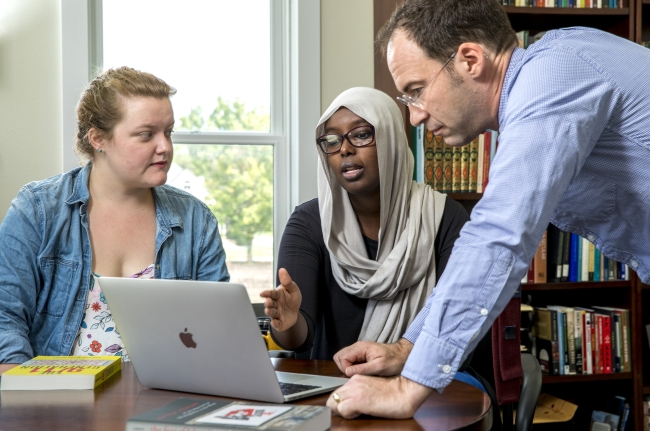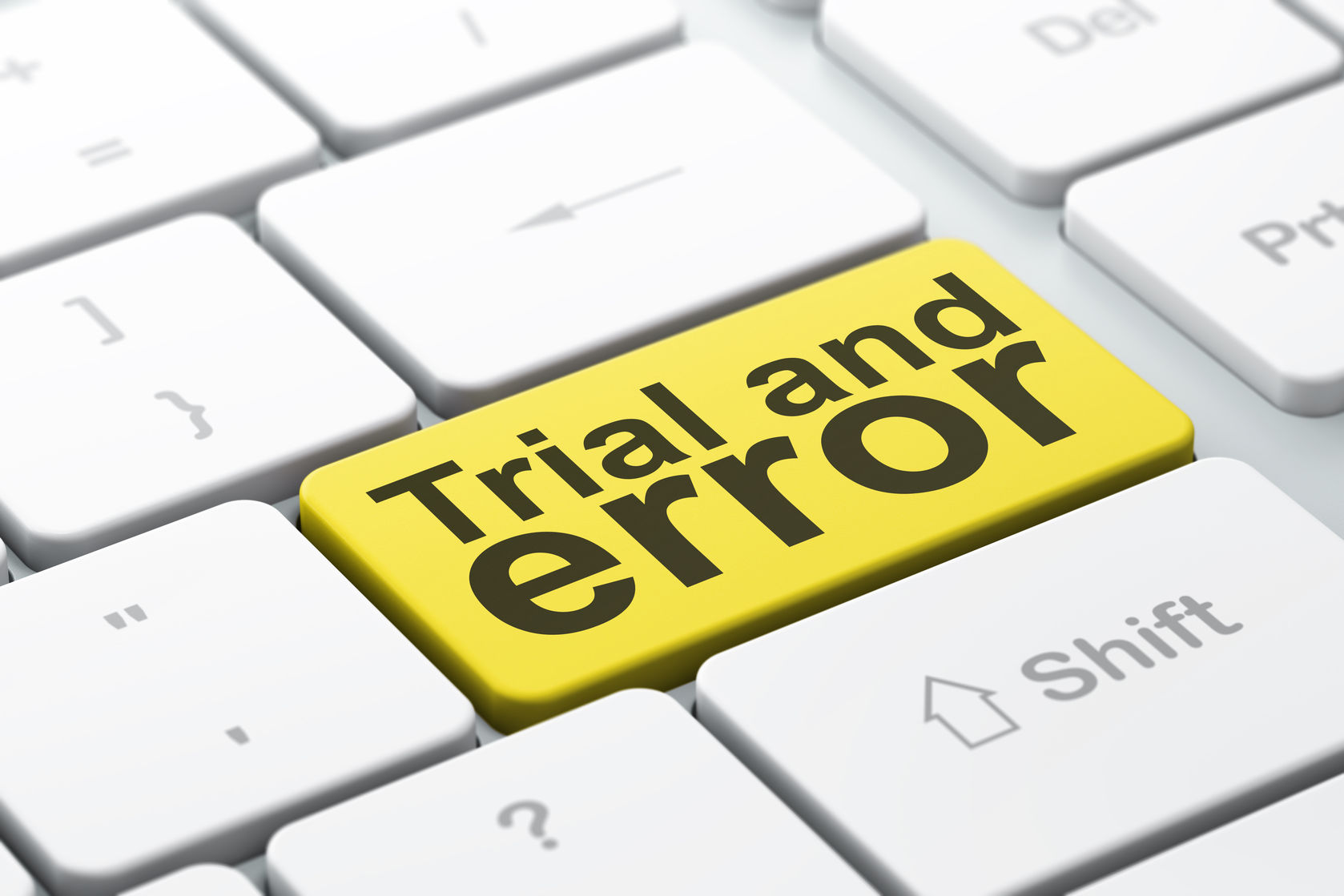You have /5 articles left.
Sign up for a free account or log in.

Two students confer with associate professor Caleb Elfenbein about his Mapping Islamophobia digital project.
Justin Hayworth / Grinnell College
The Institutions: Grinnell College and University of Iowa
The Problem: While institutions around the country were making increasing strides toward digital innovation in teaching and learning, Grinnell College watched and wanted to participate, but struggled to find an obvious entry point.
The Goal: As much as Grinnell prioritizes instilling “classic liberal arts abilities” in its students, according to Michael Latham, vice president for academic affairs and dean, new initiatives were geared towards improving students’ abilities in using technology effectively, analyzing data and shifting between digital platforms. Longer term, administrators also wanted professors to be more open to incorporating technology into curricula in their face-to-face classes.
The Experiment: Supported by a $1.6 million grant from the Andrew W. Mellon Foundation, Grinnell and the University of Iowa teamed up in 2015 for a four-year collaboration on digital humanities. The project was notable at the time for being one of the first such partnerships between a private liberal arts college (1,600 students) and a public university (33,000 students). Given the operational and atmospheric differences between the two institutions, some observers wondered whether the pair could find enough common ground to succeed.
While the idea originated at Grinnell, there were benefits for Iowa, too. The university had been making investments in digital humanities, including hiring a faculty cluster and creating a graduate certificate program. Students in that program would work with Grinnell professors to learn how to create and use digital resources in a liberal arts college setting.
What Worked: The Grinnell-Iowa team hit the ground running with a meeting of 20 faculty members representing both institutions to discuss strategy and establish the project’s technical possibilities. Because the grant didn’t prescribe specific projects or mandate particular technology tools, instructors had plenty of room to maneuver. The digital efforts ramped up slowly, but then took off last year once faculty members got more comfortable with working together and expanding their technological horizons.
Attempts to pair like-minded instructors ultimately proved less successful than a more organic approach. A professor at one institution would tentatively pursue an idea or passion project; once he or she got it going, the instructor would connect with someone at the other institution who could enhance the effort.
“It was often difficult to say, you two people are mildly interested in something similar, let’s get you together. But [it was] much easier to help one person get moving on something so they’ve got something to talk about, let someone else see how interesting that is and form a team out of that,” said Erik Simpson, professor of English at Grinnell. “That’s a model that I don’t think we expected at the beginning.”
“We really learned how to think of ourselves not as a group of people who all do the same thing but as an active team,” added Teresa Mangum, professor of gender, women's and sexuality studies at Iowa and director of the Obermann Center for Advanced Studies.
The same approach also led the institutions to emphasize collaborations between faculty members with different areas of expertise. As a public institution, Iowa is particularly adept at crafting interdisciplinary collaborations that Grinnell can follow, according to Mangum.
One such project, “Mapping Islamophobia,” combined the talents of Caleb Elfenbein, associate professor of history and religious studies at Grinnell and director of the Center for the Humanities, and Jason Harshman, assistant professor of education at Iowa. Elfenbein had the initial idea after attending a conference on post-colonial-era digital humanities. His broad goal was to create a visual representation of prejudice against Islam in America after 2001. He toiled for a while with a few Grinnell students, but hit something of a roadblock when thinking about how K-12 educators could use his tool to enlighten and inform their students.
That’s where Harshman came in, offering insights into how teachers might benefit from his software. Harshman concurred with Elfenbein’s instinct not to overwhelm viewers of his map with too much analysis at the outset. Instead, thanks to Harshman’s guidance, the facts speak for themselves.
“Working with Jason has made me feel much more secure about my decisions,” Elfenbein said. “It’s really just seeing how someone else might take this tool I created and use it in ways I could not have foreseen myself.”
Other grant-funded efforts include a visually striking map of Jews in London from the Middle Ages to the present day; a virtual clinic where religious studies students could examine ethical challenges while drawing on theoretical and philosophical texts; and a web-based tracker of African-American graduate students in the Midwest. (A more complete list of Grinnell-Iowa digital humanities projects to date is available here.)
What Didn’t: The grant kicked in almost immediately after it was announced, which meant the team didn’t have much time to plan before jumping into the fray. The funding also prompted a jarring culture shift among professors, many of whom designed and taught classes on their own. Now they were faced with the opportunity -- and the challenge -- to be creative as a team.
At times during the first year, professors struggled to shake the mindset that they had to do it all. By the second year, they began to realize that they could focus on their strengths and allow others to fill in their weak spots.
If the partners could go back in time and revise their strategy, they likely would have devoted more time early on to “a stronger sense of sequencing,” Simpson said. Had they paced themselves, they might have arrived at their comfort level earlier in the process, he added.
“Now we see that things that we had trouble selling the faculty on are becoming so easy and natural to talk about,” Simpson said.
On the other hand, an early idea to emphasize in-person collaboration among instructors never took off, due in part to the 60 miles between the two campuses. Simpson and Mangum spent the first two years trying to create interest groups that would meet on one campus a few times per semester to exchange ideas. But professors who had begun making connections to faculty members at the other institution wanted a more specific reason to extend their investment into a face-to-face meeting. Differences in culture between Grinnell and Iowa, including disparate academic calendar, contributed to those challenges, too, according to Mangum.
What’s Next: Grinnell and Iowa officials are proud of the degree to which they’ve “normalized” the marriage of technology and the humanities. They’re looking ahead to “culminating conference,” which will likely feature national and international figures from some of the areas of study that emerged from the grant. Once the grant ends, Simpson and Mangum hope the momentum will be strong enough that the institutions’ digital efforts can continue at a similar pace.
“Growth and maintenance planning will be a lot of what we do,” Simpson said.
The increasing emphasis on technology at Grinnell is even shaping planning for new buildings on campus, according to Latham. Overall, he believes the grant will leave a powerful legacy. “I think the grant is actually going to enable us to make this more and more a part of our culture and more and more a part of the work that we do,” he said. “We’ve built some nice partnerships with [University of Iowa] faculty which I’m eager to see continue.”




